Newsworthy Notebooks (Part 5): Customize with Magnets, Hooks, and Apps

Last time, we talked about the importance of being able to customize your notebook, both for style and efficiency. If you like the aesthetics of your notebook, you’ll be more likely to grab it and keep it with you; if you can adjust the setup so that your sections and accessories are available in the order in which you prefer, you’ll be more committed to your note-taking or writing system.
In that last post, we looked at disc-based notebooks, the classic method for customization. But there’s a whole new slew of modular notebooks that let you achieve customization, without discs, but combined with other intriguing features.
AXIS BY ROCKETBOOK
Way back in the second post in this series, in Noteworthy Notebooks (Part 2): The Big Names in Erasable Notebooks, we looked at how Rocketbook, creating what they call their “Notebooks from the Future” used erasability to make a variety of perpetual, environment-soothing notebooks. In that post, I alerted you that there was another edition I’d yet to detail. The wait is over!
Axis (by Rocketbook) Reusable Notebook
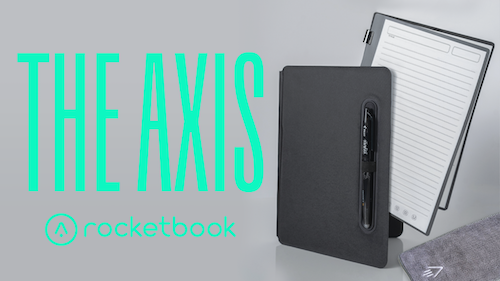
They may be the big dogs these days, but Rocketbook still launches all of its notebooks via love-fest crowdfunding, and the Kickstarter campaign for Axis was no different. The Axis campaign was such a success that, although the funding goal was only about $11,000, in the first 24 hours, by March 31, 2021, Rocketbook raised more than $100,000. By the end of April, fans pledged more than half a million dollars!
So, let’s say you’re sold on the basic Rocketbook erasable concept, but you want something a little higher tech. Enter: Axis.
What’s Back?
Axis has all of the features of the earlier versions of Rocketbook. To start with, it’s reusable. Use the same Pilot FriXion erasable pens to take notes, set your goals, track your habits, doodle a new furniture layout, draft your two week’s notice because you’re leaving your retail job to become an astronaut. Tidying up? Just erase with a little water by dampening the included microfiber towel and wiping.
Once you’ve created something (but before you erase it), if you want to preserve it forever, your Axis is cloud-connected. You can scan it using the Rocketbook app and send your creations to any of your preferred cloud services, like Evernote, OneNote, Dropbox, Box, Google Drive, iCloud, Slack, or even email.
Hate that feeling of fumble-thumbs when trying to focus to scan with your phone? Rocketbook has thought of that. I’ve always liked how my Bank of America mobile deposit app lets me hold the phone over my check and it auto-focuses, snapping the picture without any effort from me, and I’ve often wished all phone scanning worked like that. Well, Rocketbook does! The Rocketbook app uses machine vision to search the page, focus, and scan. There’s no need to push a button.
Another nice feature is that you can bundle PDFs in one scanning session. So, if you’re scanning a handful of adjacent pages that have the same “destination” symbol (like for Dropbox) marked, the app will combine the PDFs of all the pages into one.
Rocketbook reports that its app’s “computer vision” captures handwriting perfectly, no matter the angle, and “auto-crops and color-pops your scans to provide a digital version that’s lightyears ahead of the real thing and easy to read.” And as before, there’s a Smart Title Bar at the top each Axis page, so the app uses OCR to read your handwritten title and automatically name your file.
So, right now, you’re thinking, what’s the big deal? All the Rocketbook stuff works like that. But what’s different is what’s going on inside the Axis.
What’s New?
All of the other Rocketbook notebooks, from the original Wave, through the Core, Fuxion, and Matrix, had a spiral poly binding on the left side. The Flip and Mini had spiral binding at the top. And they all had simple paper or poly covers, fine but perhaps a little flimsy. And the pages, themselves, were set. Depending on the version you picked, you either had a certain number of lined or dot-grid or whatever pages, and that was that.
Axis is different. The notebook has two elements: the hard composite cover with a textured outer surface and interchangeable page packs with different paper designs. The hard cover comes in two sizes, Executive (6 3/4″ wide x 9 5/12″ hight) and Letter (9 1/4″ wide x 11 1/2″ high). There’s an indentation in the cover to hold a pen, which they’re calling a “pen pool” and an elastic band to hold the pen in place.
The page packs come in eleven different styles: lined/dot-grid combinations, lined, dot-grid, graph, blank, Cornell (AKA: annotated), meeting notes, monthly and weekly planner, health and fitness tracking, daily to-do/task tracking, and Dungeons & Dragons character sheets. Yes, really.
The pages still have the same Rocketbook QR code and symbols for cloud service destinations, but they’re arranged in specific packs by use type and design. Switch out one set of the individual, modular page packs and insert another — without discs, rings, or any fiddling. How?
Magnets!
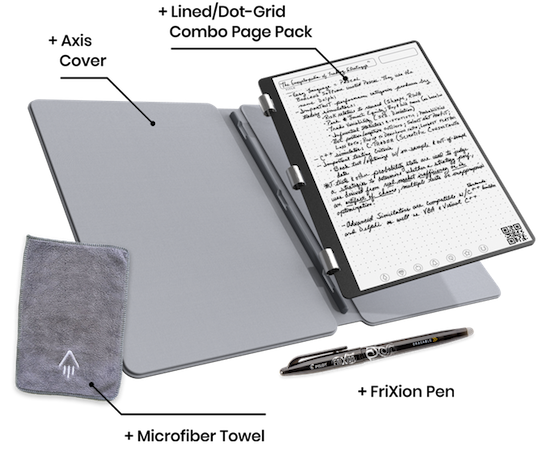
The folding spine of the hard Axis cover has rare-earth magnets embedded in it. The page packs are fastened together with three spaced, low-profile, high-density ferrous metal rings, which clamp down on the paper and attach to the spine of the Axis.
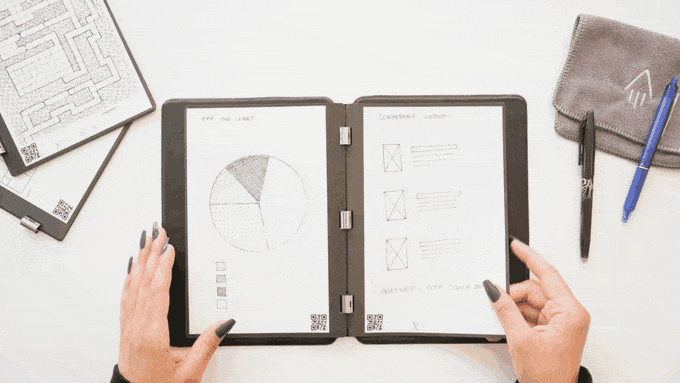
According to Rocketbook, the magnets have a “magnetic power of 7.05 lbs, which is strong enough to hold over $140 in US quarters (or a small baby).” While I’d be concerned about your baby’s diet if she’s actually magnetic, this is nonetheless an intriguing approach.
If you missed out on ordering an Axis during the crowdfunding campaign, you can sign up to be notified when the Axis is available for general purchase. Until then, watch these kooky Rocketbook folks talk about their creation, and see why they once got laughed off Shark Tank.
TRULY MINE
Imagine if, instead of merely moving around the order of the pages in your paper notebook, you could personally design your notebook to have all of the content you want. Not just ruled or dot-grid, not just calendar pages or shopping lists, but truly personalized pages and sections! That’s the concept behind Truly Mine, an online digital design system to come up with your ideal notebook.
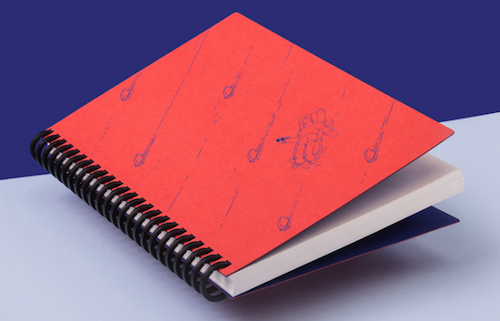
The basic process? In the Truly Mine online workshop, browse the layout library
- Select the page layouts of your choice
- Select the number of pages
- Set the order of the pages you want.
- Select a cover.
You can start with one of their template notebooks or begin completely from scratch, and add calendars, blank pages, or other notebook “essentials” (which some – by which I mean I – might call goofy luxuries) to mix-and-match for your personal Truly Mine notebook style. Once you’re set, they grab the pages, put it all together, and ship it to you.
Truly Mine prides itself on “beautiful pages that you will love to use every day.” So, visit the Truly Mine online workshop app in your browser, and start picking options. For example, let’s say you choose the Chef de Cuisine template. First, you’ll see a pop-up screen that looks like this:
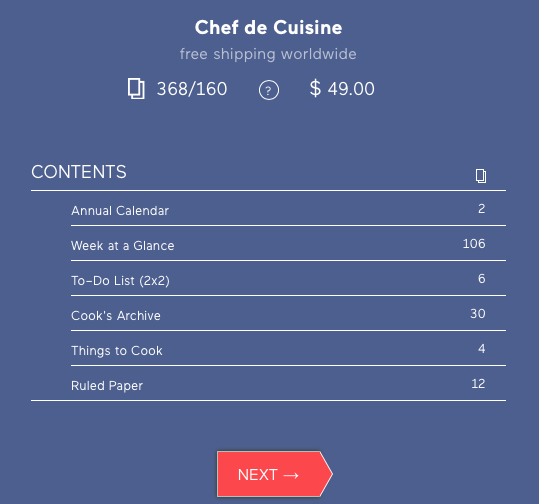
If you click Next, you’ll be asked, screen by screen, to customize some of the lines above. You’ll get to select and confirm the calendar year you want, as well as the start and end dates of the week-at-a-glance pages (in case you want weekly pages for multiple years). Since you wanted the Chef de Cuisine template, the task pages, Cook’s Archive, Things to Cook, and ruled pages are standard, but then you can add any of tons of other layouts.
Some of the layouts are not that unusual: address book pages, blanks, grids, graphs, and so on. But then, depending on your needs, you might choose from a variety of personal or business page layouts: basketball, football, and ice hockey playbook sheets, marketing campaign briefs, coffee brewer’s journal pages, daily stand-up meeting agendas, life mandalas, music staffs and guitar tabs, lending logs, runner logs, nursing notes, storyboards, tea-steeping notes, vocabulary pages, rum-tasting notes, and more.

Each page design comes with a visual and a description, plus information about the layout’s designer, so if you’ve never heard of it, you can still figure out if you might like it. (Did you know about Petr Ludwig’s “bully sheets” for tracking habits and conquering procrastination? I specialize in productivity, but I didn’t know!)
So let’s say you need a Soccer Mom Snack-Bringing Schedule layout, but it doesn’t exist yet. You know you it’ll need a calendar and a place to identify the food type and number of servings, plus whether you’ll need a cooler or spoons or whatnot. (Seriously, folks, I’m making this up, so I don’t have a clue.) You can send a suggestion and draft to contribute a layout, so even if you’re not an artist, the Truly Mine folks can make it happen.
Each Truly Mine notebook is standard at 160 A5 (5 7/8″ wide x 8 1/4″ high) pages of fountain pen-friendly 120g FSC certified premium paper. You get to keep adding pages until you hit 160, but if you have enough layouts for your needs, you can just add blank pages.
There are fifteen silkscreened cover options in four color schemes (black, red, yellow, or grey) with a variety of patterns and drawings with white or black accents, including a bunny, outer space, and the outline of a house and bicycle.
The Truly Mine notebooks run $49 plus shipping.
BOOK NOTA
Norman Wang and the Taiwanese design team Antou set out to raise $3000 on Kickstarter during May, 2021 for their notebooks for visual designers. Instead, they raised more than $120,000 in the month-long campaign for their Book Nota design.
The Book NOTA is a flexible, modular notebook with a magnetic binding, though quite different from the one we saw with Axis, above. Take a peek:
The Book NOTA system starts with the binders. They use a space-grade aluminum alloy to create a stable and durable book binder and matching notebook spine. The binder comes in two colors, Titanium Silver and Black Onyx.
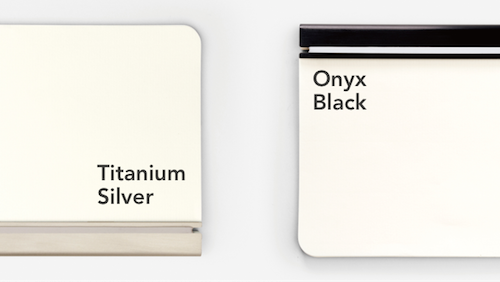
Individual sheets or stacks of paper fit into the notched-end binders and hold tightly, but you can remove individual sheets from any binder. Purchase the pre-made template sheets or create your own pages (even folding down much larger sheets to fit the binders) by using a special Book NOTA “slot puncher.”
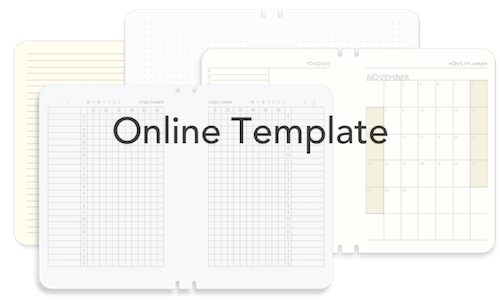
In addition to paper/refills, you can also use the magnetic binders to hold any of a variety of Book Nota accessories, like leather pouches, business card and tape flag holders, tool kits, and pencil cases.
Book NOTA covers are leather, and come in British Tan and Charcoal Black, and the magnetic spines tightly hold the magnetic binders in place. There are two sizes of Book NOTA. The Daily Book NOTA (5.3″ wide x 6.9″ high) is designed so that you can fit two magnetic binders of paper plus one accessory. The smaller Book NOTA Lite (5.3″ wide x 6.58″ high) accommodates just one paper binder.
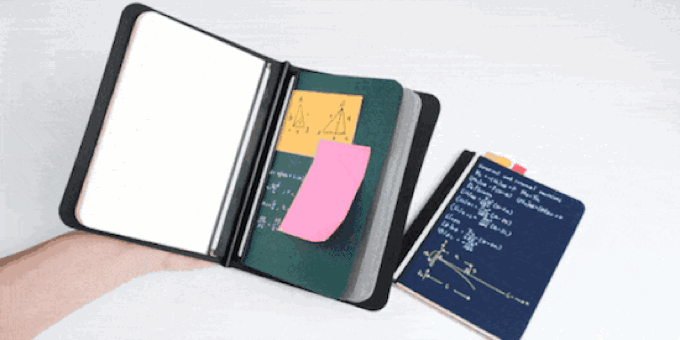
So, you slide papers into magnetic binders, and magnetic binders in the magnetic-spined leather notebook. When your not using your various other binders for not-now projects, they can magnetically hug one another on your shelf. (I advise keeping them far away from your computer or any external drives!)
Book Nota was created with analog design teams in mind, in situations where members will want to share their doodles and drawings with one another on paper. As such, it’s less of a writing notebook, and not exactly in the typical Paper Doll reader wheelhouse, so if you want more details than I’ve provided, I encourage you to read the Kickstarter campaign page. Just note that the translations into English aren’t exact, so you’ll be reading things like, “ideas are fusioned” and “solidate your inspirations.”
As the Kickstarter campaign only recently ended, there’s no pricing or purchase information available at this time.
MIXIW NOTEBOOKS
Let’s start with the admission that I have no idea how to pronounce Mixiw, the Barcelona-based company founded by two friends who sought to create a modular notebook with minimal design and maximum versatility. And they’ve definitely got a different take on modularity: no discs, no magnets, no rings…just odd little hooks.
The Mixiw binding system lets you select up to five different 40-page, 2-page-spread booklets to keep in the notebook at any one time. Booklets can be removed, rearranged, or combined quickly, as necessary.
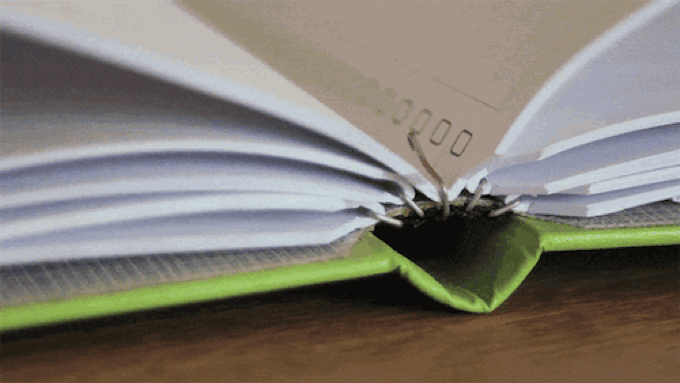
The covers of the Mixiw Notebook have hooks on the upper and lower part of the spine that both hold the booklets in place and allow you to remove or re-insert them. To remove a booklet from the cover, open it to the middle and slide it upward to separate it from the cover; to insert one, just slide a booklet in using the same method. This binding system allows the notebook to lay flat.
You get to customize your Mixiw in a number of ways:
Pick your notebook size. Mixiw comes in two standard European paper sizes, A5 (5 7/8″ wide x 8 1/4″ high) and B6 (4.9″ x 6.9″).
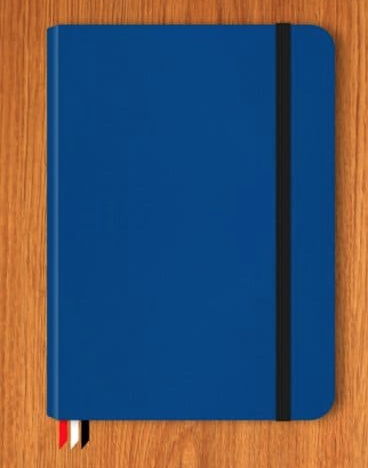
Select your cover color. Currently, the Mixiw comes in green, blue, red, black, and white. The notebooks (in either size) run 25-26 Euros (depending on whether you want the additional 1 Euro adhesive pocket for the interior back of the notebook).
Mixiw Notebooks have durable, vinyl-coated exteriors. The cover interiors are fabric, with a layer of Teflon®. Both the exteriors and interiors are nonstick to repel schmutz and prevent stains.
Choose your basic booklet layouts from among: blank, dot-grid, graph, lined, check-box to-do list, perforated blank pages, and millimeter-block graph, with prices ranging from 3.5 to 7 Euros per pack.
Add planners and agendas in your preferred style, including monthly planners (dated or undated), weekly planners (dated or undated) and agendas (a 7-day view, undated), for 3.5-8 Euros per pack.
Add in special layouts, like pages for storyboarding, fashion design, musical composition, web/app design, and a few items like “business canvas” and “tempus” (two clock faces?), the purposes of which I’ve yet to figure out. They’re all 3.5-4 Euros.
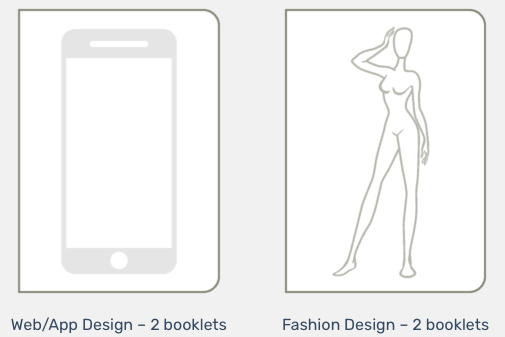
For extras, you can also choose papers for special purposes (fountain pens, illustrations, watercolors), colored paper (blue, green, orange, and yellow), and Sudoku pages, in case you feel like playing a game.
So, let’s say that during the week, you need your monthly and weekly planner, a to-do checklist, web/app design pages, and Sukoku for your commute. Dandy! But on the weekends, you can switch out three of your five, keep your weekly planner and to-do checklist, but sub in pages for making music, drawing, and fashion design. Mixiw will have you covered.
To purchase, visit the Mixiw shopping page, but for a deep dive, you may want to peek at Mixiw’s original Kickstarter page.
REKONECT G1 MAGNETIC NOTEBOOK
Perhaps you’d like to customize a notebook (maybe even page by page), and you are intrigued by the idea of magnets, but all of these options seem kind of complicated? Paper Doll has one more notebook with magnetic appeal, this time from a California-based, family-owned company.
The Rekonect G1 Magnetic Notebooks are basic but nifty. Each notebook looks like the kind you’d see someone writing in at the coffee shop or in class. Hard cover in a pretty color, elastic band, interior pages. Yadda, yadda.
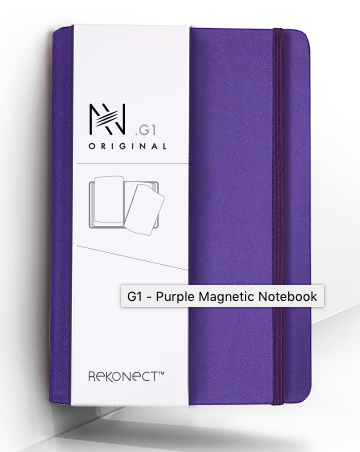
But what you can’t see until you get close up is that each of the pages is “bound” to the magnetic spine of the notebook. (Rare-earth magnets in the spine attach to the iron-coated edges of the pages.) Pull any page or group of pages out, flip forward or backward, and stick one or many in a new place. Talk about customizable, but with no muss or fuss!
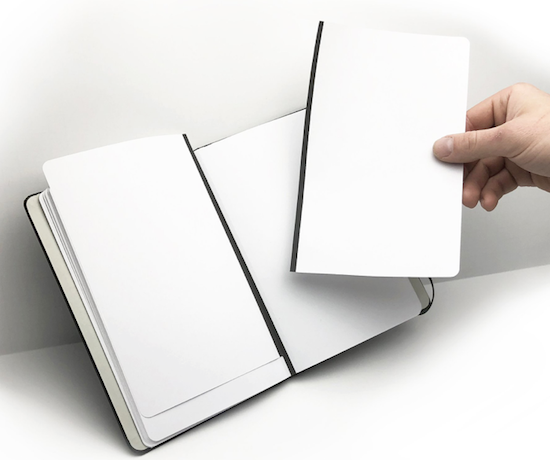
Start by selecting one of five cover colors: black, grey, blue, purple, or red. Each has a faux (they call it vegan) leather cover and binding. The Reconekt G1 Magnetic notebooks measure 5 1/2″ wide x 8″ high and hold 55 sheets (110 pages). Rekonect notebooks run $39.95.
Select interior/refill pages in four categories. The paper for the Rekonect Magnetic Notebook measures 5″ wide x 8″ high and is 98 gsm. When you order your notebook, you’ll get to choose from among blank, lined, graph, and dot-grid pages; if you want refills, they’re $11.99/pack of 55 sheets.
Although they don’t come standard with the notebooks, you can opt for 2-page spreads of weekly calendar pages for $15.99/pack. There are also divider tab page packs, with five tabbed divider pages and 45 lined pages, for $15.99.
Paper Doll doesn’t like to play favorites, but I think the Rekonect’s simplicity makes it my preferred customizable notebook of these last two posts.
Well, dear readers, what do you think? After a week of disc-bound customizable notebooks and today’s notebooks made modular through magnets, hooks, and a customizing app, do you have a favorite? Please share your thoughts in the comments section below.
There are still a few more surprises up my sleeve in this Noteworthy Notebooks series. Until then, catch up on anything you’ve missed:
Noteworthy Notebooks (Part 1): Re-Surveying the Landscape
Noteworthy Notebooks (Part 2): The Big Names in Erasable Notebooks
Noteworthy Notebooks (Part 3): More Erasable & Reusable Notebooks
Noteworthy Notebooks (Part 4): Modular, Customizable, Disc-Based Notebooks




Wow, pre-made D&D character sheets you can erase with a wet cloth? That’s fantastic!
I’m following this series closely, I’ve learned so much from it already.
I got a kick out of that one, too. My favorite products are ones that really think about all the use cases and either provide a smattering of everything or make it possible to create what you want. I’m not sure how many of my regular readers are (or know) techie D&D-playing people, but hopefully we can spread the word!
Thanks for reading!
Wow, these things are getting pretty sophisticated. I love all the customizing options. The hard case on the AXIS reminds me of an iPad. I like the feel of a leather cove, so that would be my first choice.
All of these are sort of a cross between paper and a computer. I love a book than can lay flat. I hate taking notes when I can’t get to the inside of the page because it is too near the spine. I wonder how well the hooks on that one stay in place. I’ve never seen that before.
You find all the cool stuff, Julie!
The ones in second and third weeks, the erasable notebooks, definitely had a more hybrid flair to me because you would be likely to upload before erasing. The customizable ones last week and this week felt far less computer-y (iPad-ish?) to me. We’ve got one more week of notebook that will REALLY seem like a tablet to you, and then some surprises to round out the series.
I feel the same way — if there’s a lump in the middle, I can’t write smoothly. As for hooks, I’d been trying to get more information about the Mixiw and how the hooks work, but I think the ones at the top and bottom are attached with elastics, helping tug and keep the papers in place.
Thanks for reading!
Wow! I love the Truly Mine options. Your take on what the soccer snack mom has to bring is hilarious but also so close. I could see someone (or a class mom) customizing their notebook to allow for all those little notations.
So many options.. but I can only use 1 notebook at a time! I love thinking about these modern notebook versions. I am strictly a pen and paper person. One day maybe, I’ll branch out a little more!
I think we all need to use what works for us. For me, it’s those purple pads. (And before that, all the way back to college, it’s always been legal pads.) But for keeping a journal, or tracking habits, I can see going fancier.
This has been a wild ride, looking at all the new notebooks. We’ve got a few more weeks of this, and then it’s back to how-to advice.
My goodness, Julie! I’m fascinated by how much detail and how many options you’ve discovered in this series. I love that last one- Rekonect, and the video showing how you can easily switch out the magnetic pages. Each of these notebooks/journals have awesome features. Thank you for doing all of the research, which I’ll save for future reference.
Thank you, Linda. It’s been a LONG time since I’ve done a deep-dive series like this, and it’s already got me thinking about going on on planners in the mid-Fall. I think we have two posts left in the series, one much more techie, and then a low-tech wrap-up.
If only I’d planned far ahead, I could have asked each set of designers to send me versions to review, maybe see if someone wants to do a giveaway. I guess I’m more excited about research than marketing potential. 😉
I’m getting so much from this series, Julie, including the wonderful feeling/realization that there’s a world of people out there who care passionately about this subject.
Back in the day, I used to print out customized planners for myself, take them down to Fedex to copy the pages and then get them spiral bound, which was the only option at the time (too thick for stapling). It’s amazing to see just how far others have taken their desire to truly customize their planners and notebooks.
There are bloggers who even specialize in JUST writing about notebooks. I used to read a lot of office supply and notebook blogs, but I’d gotten away from it. It’s fun catching up on all the novel methods!
I think you sold me on the Rocketbook Axis as gifts for my team. Thanks.
Aaaaaaaand this is what I love about writing this series. Every one of you seems to have a different notebook that calls to you. I’m so pleased. We’ve got a few more posts in the series, but I’m psyched that you found something you like for them.